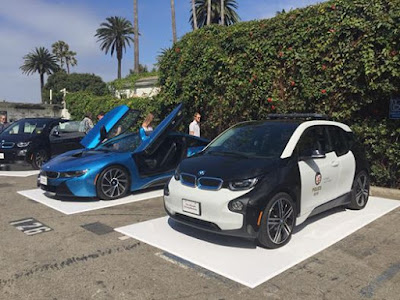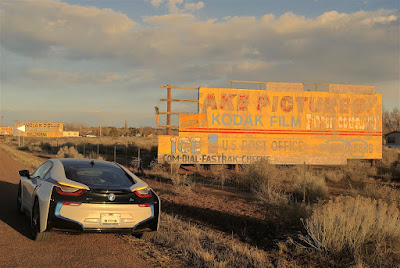10 years is a good mile-marker to reflect on visions of
the past, futile or fertile, and for a recalibration towards the
future.
We advance towards that better
future, creating solutions driven by imagination, innovation, technology,
service and a love for each other. It is faith and optimism that lights the fire of every
pioneer, pushing aside pessimism, fear and security.
The past 10 years.
Julie and I, are the owner
builders of our 2006 Net Zero Energy award winning home "Herons’ House" in Carlsbad
CA. We desired to partner with nature, one of her greatest resources in California is of
course the sun. We designed our home in 2005 to “harvest” free sunshine to power our home and future cars & transports in
lieu of fossil fuels. We purchased our
first neighborhood EV to drive on sunshine 10 years ago, the GEM E4.
Our efforts in 2005-06 were
to pioneer living and driving on sunshine.
Then, solar PV was a newish
and rare sight, electric vehicles were nowhere
to be found following the demise of the first generation of modern electric
cars in the 90’s. Living and driving completely powered
by sunshine was unheard of, our efforts derided by most as weird,
why and crazy.
Today in California, a short
10 years later, over 500,000 households have Solar PV, over 100,000 EV’s are on
the road, many if not most, powered by sunshine. Living in a solar powered home and driving an
electric vehicle powered by sunshine is now commonplace and adoption rates for
both are accelerating dramatically.
A remarkable advancement really. 10 years later, Julie and I are now normal.
A remarkable advancement really. 10 years later, Julie and I are now normal.
The next 10 years.
Vision is identifying a
better future and constructing a path towards it. With
a vision and a recalibration towards that future, here is my “Top Ten List” of what
will be viewed by most in 2016 as weird, why and crazy, and what will be viewed as normal in 2026.
1.
Transportation balance is greatly
improved between the private automobile, shared transit options, public transit, walking and bicycling. Think of the difference transport options this way: Taking a family of four to an NFL game or
taking a family of four to the beach.
One is a private event and will cost $500 or more with a small
percentage of our population being able to afford it. One is a great public
commons, free, enjoyed and equitable to all. In 2026 we will see a much improved,
more equitable balance between private, shared and public transportation, leading
to healthier and more just neighborhoods and cities.
2.
Sprawl will fall, Relocalization will ramp-up. The Interstate Highway System of 50s and 60s
greatly altered the way we traveled and the generic identity thieving way our post 1960's neighborhoods were constructed. In 2026,
relocalization will have an equally profound effect on our urban and suburban
development patterns. The electrification of transportation, autonomous cars and last mile transit solutions will lead to the relocalization of our cities,
this becoming the dominant urban design trend. Our citizens will have greater
connections within their cities, more places for people to gather, each community with their own authentic identity.
3.
Everything will be
delivered, autonomously and inexpensively.
Retail will change greatly in 2026 to be a sensory experience and a
recreational experience. If it’s not
fun, you won’t do it. This will greatly
change the urban fabric and percentage of retail.
4.
In California, 60% of all
electricity will come from renewable sources, 30% of all new passenger cars will be plug in electric. Non hydro states in the US will lag in both areas due to a later start. By 2026 no new oil, gas,
coal or nuclear power plant will ever be built in the US. Replacing fossil fuel plants will be renewable
energy plants and energy storage of many different configurations including our
cars and public transit.
5.
Buses will shrink to 10-20
passengers. The ubiquitous 40-passenger
bus will began to go extinct. The
removal of a high priced driver, the ability to drive on sunshine at 10% the
cost of gasoline and the ability to “Daisy-Train” will give rise to low cost and
effective transit solutions.
6.
A new class of low cost,
lightweight electric transport emerges.
In 2026 three wheel and four wheel vehicles weighing 1000lbs or less
will gain a large percentage of market share in our cities. These vehicles are perfect for last mile transit solutions, commuters of all distances, reductions in land needed for parking and for open air recreational driving. As cars become shared and
autonomous in greater numbers, these vehicles will find a place in nearly every
home. Driving is still fun. It’s not that we give up on cars, it’s that
we’ll have fewer of them and generally, they will be lighter.
 |
| Arcimoto SRK |
7. Batteries in 2026 increase energy density by 300% compared to 2016. Take the new BMW i3 with a range of 114 miles and triple it. Breakthroughs are happening faster with more investment and research (two years ago the same BMW i3 was released at 81 miles.) The dominant battery form factor becomes solid state and will last a lifetime.
8.
Small craft aviation shifts
to electric in 2026. 3-hour flight times
with 30 minute reserve are commonplace for 2-6 passenger small aircraft. Batteries are recharged by solar on the wings and fuselage adding to the range, fast charging is available at most airports. These aircraft operate at 1/10th
the cost of traditional aircraft.
Airports begin phasing out landing rights for certain aircraft due to
noise and emission concerns. This
phasing out will be a 30-year process resulting eventually in only electric
aviation for the small aircraft segment.
You think a dual motor Tesla is fast?
9.
The Jetson’s age is upon us. In 2026, a 40 story high skyscraper called
Skypad Apartments is planned in Los Angeles with each unit having a landing pad
for a multi passenger quad copter. The
commute to Space X Sprockets in Hawthorne CA will be automatic and take less than 5
minutes. Astro becomes the most popular
dog name in the US. Multi passenger quad copters are the new must have. Read more here.
10. Space travel. In 2026 orbital space travel begins to become
attainable. Prices drop to $50,000 (in
2016 dollars) for an orbital flight preceded by a four-day space themed cruise. Sir Richard Branson launches Virgin Space Lines. Space ports are as common as cruise ship
ports.
I can’t wait to see how
this all turns out J
What are your thoughts on the top ten electric transportation and energy breakthroughs in the next ten years?
What are your thoughts on the top ten electric transportation and energy breakthroughs in the next ten years?



















































